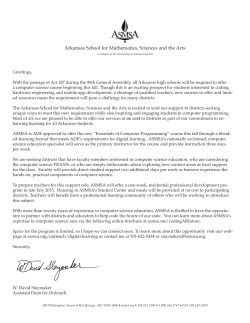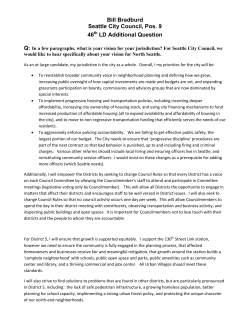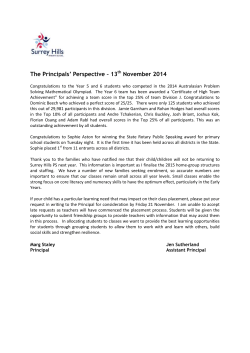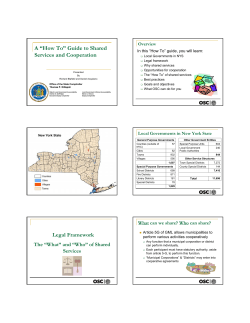
The CA District Capacity Project v5 (long version)
The California District Capacity Project Overview Background: Collaborative partnerships between labor and management are proving to be a critical pre-condition for educational change. They lead to improved trust, communication, and problem-solving among district leaders. New research is also showing an important link to improved academic outcomes for students. In their 2013 study of unionmanagement partnerships in the ABC Unified School District, Saul Rubinstein and John McCarthy report that “[t]he quality of formal partnerships between teachers’ unions, administrators, and teachers at the school level is a significant predictor of student performance as well as performance improvement, after controlling for poverty and school type.” In May, 2015, the California Labor-Management Initiative (CA LMI) was officially launched at a symposium in San Diego and is supported by the California Department of Education, the CDE Foundation, the Association of California School Administrators (ACSA), California Federation of Teachers (CFT), California School Boards Association (CSBA), California School Employees Association (CSEA), and the California Teachers Association (CTA). The CA LMI emerged from recommendations in two statewide reports. The first, A Blueprint for Great Schools, was written by a 54-member Transition Advisory Team convened in 2011 by State Superintendent of Public Instruction (SSPI) Tom Torlakson. The report viewed this initiative as an ongoing effort, “to support union-management collaboration toward high-leverage reforms in school organization, management, and instructional innovation as well 1 as educator development, support, and evaluation.” The second report, Excellence By Design, produced by the Educator Excellence Task Force, recommended the “creation of a comprehensive statewide agenda for improving 2 labor-management relations in school district across the state.” Purpose: The California District Capacity Project (CDCP) is designed to build the capacity of California’s school districts to drive improvements in student achievement. CDCP teams of superintendents, union leaders, school board members, teachers and administrators work together with CDCP facilitators to: • • • • Co-design and implement initiatives to advance student learning and success; Increase teacher engagement in leadership of school and district innovation efforts; Improve problem solving, decision making and implementation; Develop skills, structures, and policies that can sustain collaborative practice over time. Approach: Using collaborative teaming and interest-based practices, each CDCP team works to identify improvement strategies that address local needs. They draft an MOU that establishes principles to guide their work; they engage in training sessions focused on relationship-building and collaborative planning; and they co-develop work plans, timelines, and project goals. Third party facilitators with experience in labor-management collaboration assist teams in building district-wide capacity for collaboration and change that results in improved educational outcomes for students. Demonstrated Impact: The CDCP is modeled after a similar project launched in 2012 by the Rennie Center for Educational Research and Policy in Boston and overseen by the Massachusetts Education Partnership (MEP). The DCP in Massachusetts currently supports seven school districts. Of the 68,000 served by these mostly urban districts, approximately 76 1 2 See: A Blueprint for Great Schools, 2011. See: Greatness by Design: Supporting Outstanding Teaching to Sustain a Golden State, 2012. 1 percent are from low-income households, 33 percent are receiving special education services, and 69 percent are racial or ethnic minorities. Districts participating in the Massachusetts DCP have: • • • • • • Built new professional learning communities; Launched a teacher leader program that increases teaching and learning capacity while boosting compensation; Planned a dual language immersion school for a multi-lingual student body; Trained several hundred teachers and administrators in the art and practice of having difficult conversations and forging a community of dialogue; Reinvented a district’s professional development system; and Overseen the rollout of a new educator evaluation system. According to an independent evaluation of the project by the Donahue Institute at UMass, “…labor and management participants responding to the survey overwhelmingly report that: • • • • Collective bargaining, which was once viewed as an obstacle to achieving improvements in educational outcomes, has been an effective means for improvement. They are substantially more confident that the state of labor-management relations in their district is sufficient to address the need for performance improvement in education. The day-to-day relation between the superintendent and local union leaders is more collaborative and less adversarial, as are relations between teachers and school administrators. School personnel are more involved in making decisions about school operations, and in developing strategies to improve school performance, and they are more frequently encouraged to share their opinions of school programs and practices.”3 California’s DCP Offerings Each District Team is assigned a CDCP facilitator -- an educational leader with successful experience with labormanagement partnerships who devotes 100 on-site hours during the year helping teams develop collaborative norms, identify shared interests, implement joint projects, and monitor progress. Each District Team would also participate in two, one-day CDCP Institutes during the year. These events bring CDCP teams together for in-depth technical assistance, networking opportunities, and planning time. Topics for the Institutes include: • • • • • • Strategies for building trust and a district-wide culture of collaboration Establishing norms of collaboration Identifying obstacles to collaboration Anger-free, safe dialogue for (i.e., “crucial conversations”) for conflict resolution Exploration of projects to implement collaboratively (see list below) Team time for goal setting and planning CDCP teams are encouraged to select a joint project of their choice that they will work on collaboratively. These are examples of projects for CDCP districts to consider. Many others are possible: • • • Common Core implementation Local Control Accountability Plans (LCAP) Linked Learning programs for high schools 3 UMass Donohue Institute (2014), District Capacity Project – Evaluation Report. Findings from Two Years of Program Implementation. 2 • • • • • • • • • • Professional learning programs for teachers, administrators, and classified staff Peer assistance and review programs Mastering difficult conversations that advance innovation, problem solving, and student learning Expanded learning time programs Strengthening programming for English language learners Strengthening programming for special education students Addressing the non-academic barriers to learning for students Collaboration with the local community Wrap-around services for families Career lattice programs for teachers What Participating District Teams Provide District Teams agree: • To include, at a minimum, the superintendent, the union president, and a member of the school board on the district’s labor-management team. • To develop a work plan on which to focus their collaborative work during the school year. Work plans include goals and activities that can be implemented immediately, without having to address the current collective bargaining agreement. • To have the whole team meet at least once each month for at least half a day with a CDCP facilitator. Monthly meetings focus on work plan progress, project implementation, and troubleshooting. • To advance their work in the period between monthly meetings rather than relying on the monthly meetings themselves to drive the work. • To participate in two CDCP statewide Capacity Institutes during the year. Districts must pay for travel costs to and from the Institutes. • To pay $10,000 in fees for participation in the CDCP. A portion of the costs for facilitation and Capacity Institutes would be paid by outside sources. (The additional $45,000 in program costs will be provided from other sources.) CDCP Leadership The CDCP operates under the aegis of the California Labor-Management Initiative (CA LMI). The CA LMI is led by the CDE Foundation (CDEF), the California Department of Education (CDE), the California Teachers Association (CTA), the California Federation of Teachers (CFT), the Association for California School Administrators (ACSA), the California School Boards Association (CSBA), and the California School Employees Association (CSEA). For more information on the CA LMI, please visit: www.cdefoundation.org/lmi. Project Management and Staffing: The CDE Foundation will oversee the District Capacity Project and be directed by Ken Futernick. Futernick directed WestEd’s School Turnaround Center from 2008 to 2014 and managed a labor-management project funded by the Ford Foundation. Futernick was the principal author of two research reports on labor-management collaboration. The first, Forward Together: Better Schools Through Labor-Management Collaboration, was a follow up study of the 2011 national labor-management conference. The second, Labor-Management Collaboration in Education: The Process, the Impact, and the Prospects for Change, analyzed 55 case studies of school districts that have engaged in labor-management collaboration. In 2012, Futernick served on California State Superintendent Tom Torlakson’s Educator Excellence Task Force and authored the recommendations for labor-management collaboration that appeared in the Task Force’s report, Greatness By Design. He is currently a member of a support team for California’s Labor-Management Initiative. Futernick is currently authoring a book on labor-management collaboration that will be published in fall 2015. 3 Program Costs The approximate cost for each district to participate in the CDCP for one year is $55,000. Costs are for onsite facilitation, two all-day Capacity Institutes, and program administration. Currently, the CDE Foundation has grant funding to cover $10,000 in costs for 5 districts. Each participating district would also contribute $10,000. The additional $35,000 would come from other organizations and foundations. District Application and Selection Process All districts in California are eligible for the CDCP. Once sufficient funding has been obtained districts interested in participating will have an opportunity to submit a formal CDCP Application. Final selection of the district teams will be made by the CA LMI “working group,” which represents leaders from each of CA LMI’s partner organizations. Considerations for selection: • District teams that demonstrate a strong desire to collaborate and to participate in the capacity building activities (i.e., Capacity Institutes and monthly meetings); • District teams whose members include a variety of leaders (teachers, principals, district administrators, school board members, union officers, community leaders, parents, etc.); • A mix of large and small districts. Project Timeline: If a sufficient number of districts apply and funding can be found, the CDCP could be launched as early as the fall of 2015. Districts would need to apply by late spring. For inquires, please contact Shelly Masur at the CDE Foundation: shelly@cdefoundation.org 4
© Copyright 2025









